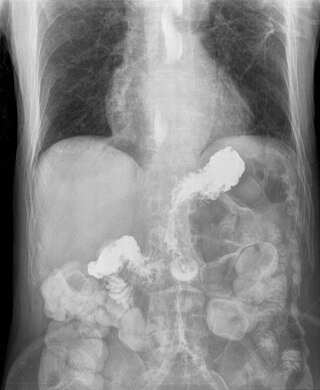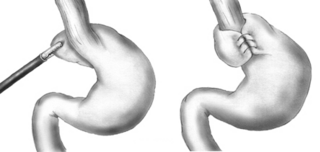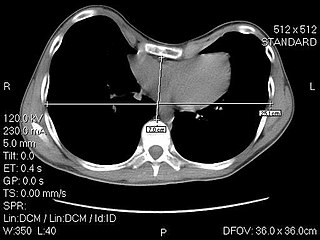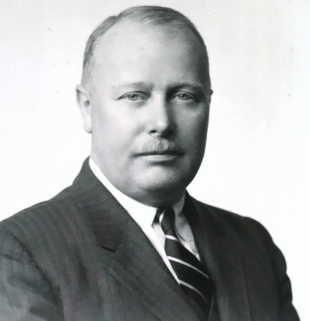Related Research Articles

Esophageal achalasia, often referred to simply as achalasia, is a failure of smooth muscle fibers to relax, which can cause the lower esophageal sphincter to remain closed. Without a modifier, "achalasia" usually refers to achalasia of the esophagus. Achalasia can happen at various points along the gastrointestinal tract; achalasia of the rectum, for instance, may occur in Hirschsprung's disease. The lower esophageal sphincter is a muscle between the esophagus and stomach that opens when food comes in. It closes to avoid stomach acids from coming back up. A fully understood cause to the disease is unknown, as are factors that increase the risk of its appearance. Suggestions of a genetically transmittable form of achalasia exist, but this is neither fully understood, nor agreed upon.

Gastroesophageal reflux disease (GERD) or gastro-oesophageal reflux disease (GORD) is one of the upper gastrointestinal chronic diseases where stomach content persistently and regularly flows up into the esophagus, resulting in symptoms and/or complications. Symptoms include dental corrosion, dysphagia, heartburn, odynophagia, regurgitation, non-cardiac chest pain, extraesophageal symptoms such as chronic cough, hoarseness, reflux-induced laryngitis, or asthma. On the long term, and when not treated, complications such as esophagitis, esophageal stricture, and Barrett's esophagus may arise.

A Nissen fundoplication, or laparoscopic Nissen fundoplication when performed via laparoscopic surgery, is a surgical procedure to treat gastroesophageal reflux disease (GERD) and hiatal hernia. In GERD, it is usually performed when medical therapy has failed; but, with a Type II (paraesophageal) hiatus hernia, it is the first-line procedure. The Nissen fundoplication is total (360°), but partial fundoplications known as Thal, Belsey, Dor, Lind, and Toupet fundoplications are alternative procedures with somewhat different indications and outcomes.

Pectus excavatum is a structural deformity of the anterior thoracic wall in which the sternum and rib cage are shaped abnormally. This produces a caved-in or sunken appearance of the chest. It can either be present at birth or develop after puberty.

Orchiopexy is a surgery to move and/or permanently fix a testicle into the scrotum. While orchiopexy typically describes the operation to surgically correct an undescended testicle, it is also used to resolve testicular torsion.

Gastroschisis is a birth defect in which the baby's intestines extend outside of the abdomen through a hole next to the belly button. The size of the hole is variable, and other organs including the stomach and liver may also occur outside the baby's body. Complications may include feeding problems, prematurity, intestinal atresia, and intrauterine growth restriction.
Intestinal malrotation is a congenital anomaly of rotation of the midgut. It occurs during the first trimester as the fetal gut undergoes a complex series of growth and development. Malrotation can lead to a dangerous complication called volvulus. Malrotation can refer to a spectrum of abnormal intestinal positioning, often including:

Intestinal atresia is any congenital malformation of the structure of the intestine that causes bowel obstruction. The malformation can be a narrowing (stenosis), absence or malrotation of a portion of the intestine. These defects can either occur in the small or large intestine.

Currarino syndrome is an inherited congenital disorder where either the sacrum is not formed properly, or there is a mass in the presacral space in front of the sacrum, and there are malformations of the anus or rectum. It occurs in approximately 1 in 100,000 people.

The Haller index, created in 1987 by J. Alex Haller, S. S. Kramer, and S. A. Lietman, is a mathematical relationship that exists in a human chest section observed with a CT scan. It is defined as the ratio of the transverse diameter and the anteroposterior diameter.
Sandifer syndrome is an eponymous paediatric medical disorder, characterised by gastrointestinal symptoms and associated neurological features. There is a significant correlation between the syndrome and gastro-oesophageal reflux disease (GORD); however, it is estimated to occur in less than 1% of children with reflux.

Pulmonary hypoplasia is incomplete development of the lungs, resulting in an abnormally low number or size of bronchopulmonary segments or alveoli. A congenital malformation, it most often occurs secondary to other fetal abnormalities that interfere with normal development of the lungs. Primary (idiopathic) pulmonary hypoplasia is rare and usually not associated with other maternal or fetal abnormalities.

Chest pain in children is the pain felt in the chest by infants, children and adolescents. In most cases the pain is not associated with the heart. It is primarily identified by the observance or report of pain by the infant, child or adolescent by reports of distress by parents or caregivers. Chest pain is not uncommon in children. Many children are seen in ambulatory clinics, emergency departments and hospitals and cardiology clinics. Most often there is a benign cause for the pain for most children. Some have conditions that are serious and possibly life-threatening. Chest pain in pediatric patients requires careful physical examination and a detailed history that would indicate the possibility of a serious cause. Studies of pediatric chest pain are sparse. It has been difficult to create evidence-based guidelines for evaluation.

Morio Kasai was a Japanese surgeon who had a strong interest in pediatric surgery. While Kasai went into practice at a time when pediatric surgery was not an established subspecialty, much of his clinical and research work was related to the surgical care of children. He is best known for devising a surgical procedure, the hepatoportoenterostomy, to address a life-threatening birth defect known as biliary atresia. The modern form of the operation is still known as the Kasai procedure.
Lewis Spitz is a paediatric surgeon who is internationally recognised as a leader in paediatric surgery and is known for his work on congenital abnormalities of the oesophagus, particularly oesophageal atresia, oesophageal replacement and gastroesophageal reflux especially in neurologically impaired children. He championed the plight of children with cerebral palsy and other congenital disorders; demonstrating that appropriate surgery could improve their quality of life. He is the leading authority in the management of conjoined twins and is recognised as the foremost international expert in this field. Spitz is the Emeritus Nuffield Professor of Paediatric Surgery.

Orvar Swenson was a Swedish-born American pediatric surgeon. He discovered the cause of Hirschsprung's disease and in 1948, with Alexander Bill, performed the first pull-through operation in a child with megacolon, which then became a treatment for the disease.
Caudal duplication, is a rare congenital disorder in which various structures of the caudal region, embryonic cloaca, and neural tube exhibit a spectrum of abnormalities such as duplication and malformations. The exact causes of the condition is unknown, though there are several theories implicating abnormal embryological development as a cause for the condition. Diagnosis is often made during prenatal development of the second trimester through anomaly scans or immediately after birth. However, rare cases of adulthood diagnosis has also been observed. Treatment is often required to correct such abnormalities according to the range of symptoms present, whilst treatment options vary from conservative expectant management to resection of caudal tissue to restore normal function or appearance. As a rare congenital disorder, the prevalence at birth is less than 1 per 100,000 with less than 100 cases reported worldwide.
Denis Browne Gold Medal is a medal that was first struck in 1968, one year after the death of the paediatric surgeon Denis Browne and is awarded for outstanding contributions to paediatric surgery worldwide and is an honour bestowed by The British Association of Paediatric Surgeons.
Andrea A. Hayes Dixon is an American surgeon. She was the first pediatric surgeon to perform a high-risk, life-saving procedure in children with a rare form of cancer and developed the first orthotropic xenograft model of metastatic Ewing's sarcoma. In 2002, she became the first African American female pediatric surgeon board-certified in the United States.
The effects of early-life exposures to anesthesia on the brain in humans are controversial. Evidence from nonhuman primate research suggests significant developmental neurotoxicity and long-term social impairment, with a dose–response relationship where repeated exposures cause a more severe impact than single ones. Research in humans has not found conclusive clinical evidence of cognitive impairment; however, systematic reviews imply the possibility of greater behavioural impairments in children exposed to anesthesia before the age of three than control subjects.
References
- ↑ Bianchi, A (September 1997). "Total esophagogastric dissociation: An alternative approach". Journal of Pediatric Surgery. 32 (9): 1291–1294. doi:10.1016/s0022-3468(97)90304-3. ISSN 0022-3468. PMID 9314245.
- ↑ Gatti, C.; di Abriola, G.Federici; Villa, M.; De Angelis, P.; Laviani, R.; La Sala, E.; Dall'Oglio, L. (May 2001). "Esophagogastric dissociation versus fundoplication: Which is best for severely neurologically impaired children?". Journal of Pediatric Surgery. 36 (5): 677–680. doi:10.1053/jpsu.2001.22935. hdl: 2108/311079 . ISSN 0022-3468. PMID 11329564.
- 1 2 Morabito, Antonio; Lall, Anupam; Piccolo, R. Lo; McCarthy, Helen; Kauffmann, Lisa; Ahmed, Shiban; Bianchi, Adrian (May 2006). "Total esophagogastric dissociation: 10 years' review". Journal of Pediatric Surgery. 41 (5): 919–922. doi:10.1016/j.jpedsurg.2006.01.013. ISSN 0022-3468. PMID 16677883.
- ↑ Goyal, Anju; Khalil, Basem; Choo, Kelvin; Mohammed, Khalid; Jones, Matthew (June 2005). "Esophagogastric dissociation in the neurologically impaired: an alternative to fundoplication?". Journal of Pediatric Surgery. 40 (6): 915–919. doi:10.1016/j.jpedsurg.2005.03.004. ISSN 0022-3468. PMID 15991170.